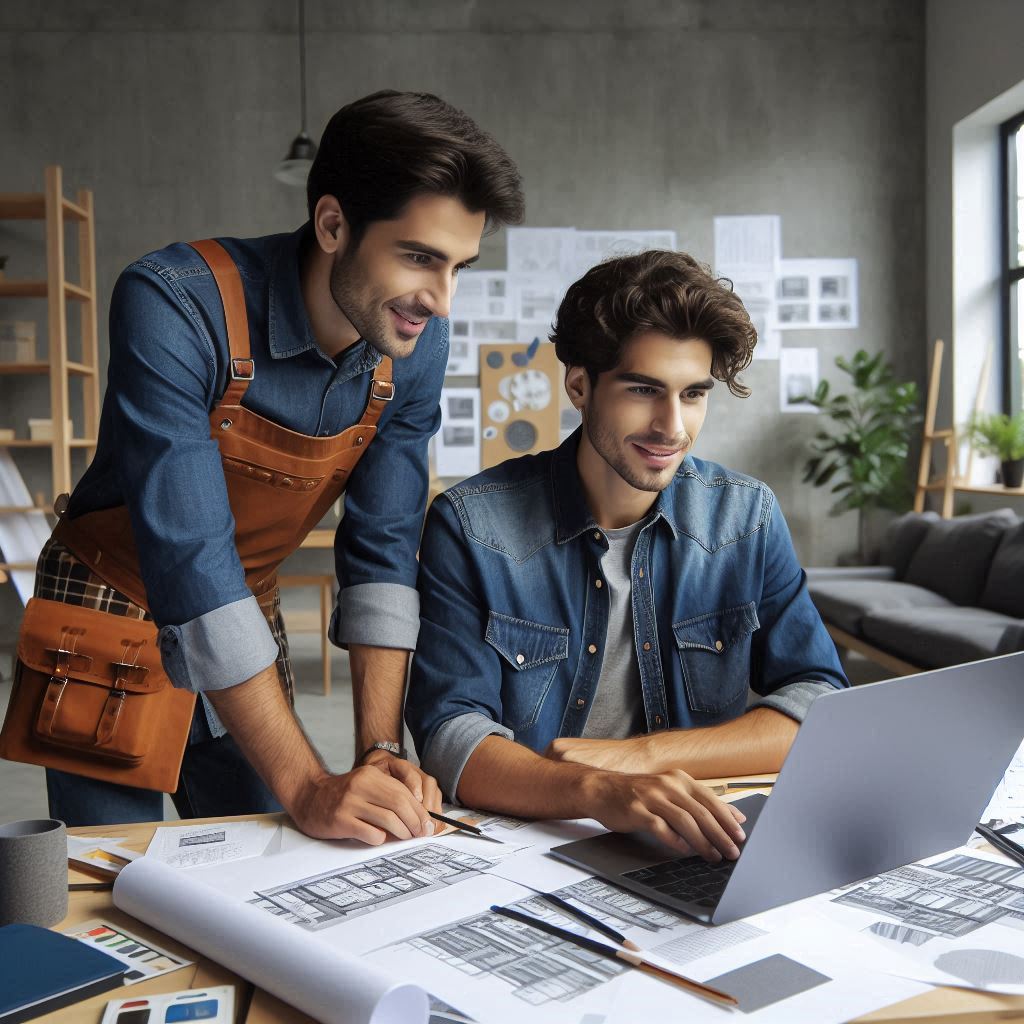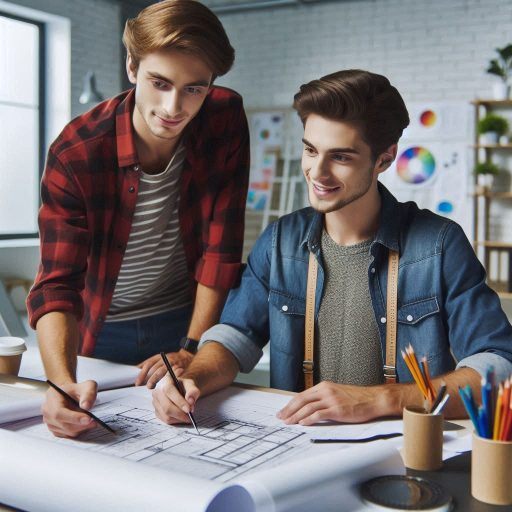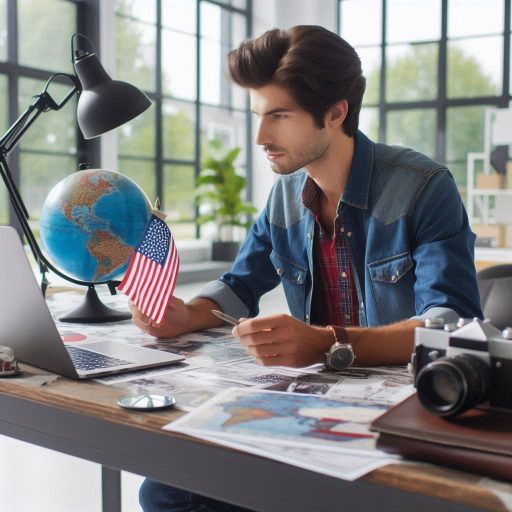Introduction
Exhibition designers play a crucial role in creating engaging spaces that leave a lasting impression.
Their work involves transforming concepts into immersive experiences that captivate audiences and convey powerful brand messages.
Effective design not only enhances visual appeal but also boosts visitor interaction and engagement, making the overall experience memorable.
To achieve stunning results, exhibition designers rely on a variety of tools that streamline the design process.
These tools enable designers to collaborate more effectively and unleash their creativity.
For instance, software applications such as AutoCAD and SketchUp allow designers to create detailed floor plans and 3D models.
This capability enables them to visualize layouts and experiment with different ideas before finalizing their designs.
Additionally, 3D modeling tools play a vital role in presenting realistic renderings of exhibition concepts.
These visualizations help clients and stakeholders understand the designer’s vision clearly, facilitating smoother decision-making.
Project management tools like Trello and Asana help teams organize communication and streamline the design process.
These tools keep teams focused on deadlines and ensure they stay on track.
Using the right tools empowers exhibition designers to deliver exceptional results that meet client expectations.
Sketching Tools for Exhibition Designers
Sketching tools play a vital role in the early stages of design for exhibition designers.
They allow designers to explore ideas freely and quickly.
Here‘s why hand-drawn sketches are essential and which tools can enhance your creative process.
Importance of Hand-Drawn Sketches
- Idea Exploration: Sketching encourages spontaneous creativity.
Designers can quickly visualize concepts without constraints. - Initial Visualization: Hand-drawn sketches help designers see how elements interact within a space.
They can adjust layouts and designs before finalizing them. - Iterative Process: Sketching allows for easy modifications.
Designers can iterate their ideas rapidly, ensuring the best concepts are developed. - Effective Communication: Hand-drawn sketches provide a visual language.
They help convey ideas clearly to clients and team members.
Recommended Sketching Tools
To maximize the benefits of sketching, consider these essential tools:
- Sketchbooks: A quality sketchbook is fundamental.
It provides a dedicated space for your ideas.
Choose one with thick, bleed-resistant paper. - Pencils: A variety of pencils can enhance your sketches.
Use hard pencils for fine lines and softer pencils for shading and depth. - Markers: Markers add vibrancy to your sketches.
They come in various colors and tip sizes, enabling detailed illustrations. - Erasers: Keep a good eraser handy for corrections.
It helps refine your sketches without damaging the paper. - Rulers and Templates: For precision, use rulers and templates.
They assist in creating straight lines and consistent shapes.
How Sketching Tools Aid Communication
Using sketching tools effectively enhances communication among team members and clients.
Here‘s how:
- Visual Representation: Hand-drawn sketches serve as visual aids.
They translate complex ideas into understandable formats. - Engagement: Presenting ideas through sketches fosters engagement.
Clients can provide immediate feedback on designs, facilitating collaboration. - Concept Validation: Sketches enable quick validation of concepts.
Designers can present multiple options and gauge client reactions. - Documentation: Sketches act as documentation of the design process.
They capture the evolution of ideas, which can be useful for future reference.
Sketching tools are indispensable for exhibition designers.
They enhance creativity, facilitate communication, and improve the overall design process.
By investing in quality sketching tools, designers can elevate their work and ensure successful exhibitions.
Embrace the power of hand-drawn sketches to communicate your ideas effectively.
Read: How to Create Memorable Characters: Pro Tips
Digital design software
Overview of Popular Software for Exhibition Design
In today‘s digital age, exhibition designers rely on advanced software tools to bring their visions to life.
Some of the most popular software in the industry includes Adobe Creative Suite, SketchUp, and AutoCAD.
Each of these tools serves distinct purposes and offers unique features that enhance the design process.
Adobe Creative Suite
Adobe Creative Suite is a comprehensive collection of professional design tools widely used in various creative fields.
Key components of the suite include:
- Photoshop: Ideal for image editing and manipulation, Photoshop allows designers to create stunning visuals, edit photographs, and enhance graphics.
- Illustrator: This vector graphics editor is perfect for creating logos, icons, and illustrations that require scalability without loss of quality.
The integration of these applications allows designers to produce cohesive and polished presentations for their exhibition projects.
SketchUp
SketchUp is renowned for its user-friendly interface and powerful 3D modeling capabilities.
It has gained popularity among exhibition designers for several reasons:
- Ease of Use: Its intuitive design makes it accessible for both beginners and experienced designers, allowing users to create 3D models quickly.
- Versatile Applications: SketchUp is ideal for conceptualizing exhibition layouts and spatial designs.
Designers can easily visualize how elements interact within a space, facilitating better planning.
AutoCAD
AutoCAD is a staple in architectural and engineering design, widely utilized for creating precise 2D and 3D drawings.
Its strengths include:
- Precision and Detail: AutoCAD allows for intricate and exact designs, making it suitable for technical drawings, floor plans, and detailed layouts.
- Industry Standard: Familiarity with AutoCAD boosts a designer’s employability.
It also increases effectiveness in collaborative environments.
Being an industry standard tool, AutoCAD is essential for designers.
Benefits of Using Digital Tools for Creating Detailed Plans and Mock-Ups
The use of digital design software has revolutionized the way exhibition designers create detailed plans and mock-ups.
Here are several benefits.
- Intricate and Accurate Designs: Digital tools empower designers to create complex and precise plans effortlessly.
These tools offer features that enhance accuracy, such as grid systems and measurement tools, reducing the likelihood of errors. - Realistic Visualizations: Digital software enables designers to visualize their concepts in a realistic manner.
Through 3D modeling and rendering, clients can gain a clearer understanding of how the final exhibition will look and feel. - Rapid Iteration and Flexibility: With digital tools, designers can quickly implement changes and experiment with various layouts.
This flexibility fosters a creative environment where ideas can be tested and refined without extensive rework. - Efficient Mock-Ups: Digital design allows for the rapid creation of mock-ups, providing clients with tangible representations of concepts.
This efficiency can significantly reduce project timelines and enhance client satisfaction.
How Software Can Streamline the Design Process and Improve Collaboration with Clients
Digital design software not only enhances the design process but also improves collaboration with clients in several impactful ways.
- Simplification of Complex Designs: These tools simplify the creation of intricate designs, streamlining the drafting process.
Designers can leverage templates and pre-designed elements to reduce the time and effort required for complex projects. - Enhanced Collaboration: Digital software facilitates easy file sharing, allowing designers to send plans and designs to clients for review.
This capability ensures that clients are involved throughout the design process, promoting transparency and trust. - Real-Time Feedback and Revisions: With collaborative features, clients can provide feedback directly on designs, allowing for real-time revisions.
This immediate communication fosters a more dynamic design process and ensures that the final product aligns with client expectations. - Informed Decision-Making: Clients can better understand proposed designs through 3D visualizations and walkthroughs.
These immersive experiences empower clients to make informed decisions and provide more constructive feedback.
Leveraging popular software like Adobe Creative Suite, SketchUp, and AutoCAD is essential for exhibition designers aiming to create impactful and successful designs.
The benefits of using digital tools extend far beyond mere convenience; they enhance creativity, streamline processes, and foster collaboration with clients.
As technology evolves, designers can embrace new tools.
These tools empower them to push the boundaries of their craft.
This leads to innovative exhibitions that captivate audiences.
Ultimately, they fulfill client visions effectively.
The integration of these digital solutions in the design process represents a crucial step towards achieving excellence in exhibition design.
Read: Ceramic Art Exhibitions to Visit in 2024
3D modeling tools
Importance of Creating Realistic Renderings for Clients to Visualize the Space
Creating realistic renderings is essential in exhibition design, as it enables clients to visualize the proposed space effectively.
3D modeling tools play a pivotal role in this process, offering designers the capability to produce detailed and accurate virtual representations of the exhibition environment.
These renderings serve as powerful communication tools that help clients grasp the design concept fully.
Making it easier for them to provide informed feedback and ultimately approve the project.
When clients can see a lifelike visualization of the space, they are better equipped to understand the proposed layout, aesthetics, and overall flow of the exhibition.
This clarity significantly enhances the decision-making process, reducing misunderstandings and aligning expectations.
For many clients, visualizing the final design is crucial, especially when dealing with abstract concepts that may not translate easily from sketches or 2D plans.
Realistic renderings bridge this gap, turning ideas into tangible visuals.
Recommended Tools: Rhino, Blender, and Revit
Several 3D modeling tools are favored by exhibition designers for their versatility and robust features.
Among the most prominent are Rhino, Blender, and Revit.
Each of these tools brings unique advantages to the table
Rhino is known for its user-friendly interface and exceptional precision in modeling complex geometries.
Its flexibility makes it ideal for creating intricate designs, allowing exhibition designers to experiment with unconventional shapes and structures.
Rhino’s capabilities in NURBS modeling enable designers to achieve high levels of detail and smooth surfaces, which are critical for creating visually appealing exhibitions.
Blender stands out as a powerful open-source software that offers an extensive range of tools for modeling, rendering, and animation.
Its capabilities go beyond traditional 3D modeling, making it a comprehensive solution for designers looking to create dynamic visual content.
Blender’s rendering engine, Cycles, allows for photorealistic rendering, giving clients an immersive experience of the proposed exhibition.
Revit, part of the Autodesk suite, is widely used in the architecture and design industry for its parametric modeling capabilities.
This feature allows designers to create intelligent models that automatically adjust when changes are made.
This capability is particularly beneficial in exhibition design, where last-minute modifications are often required.
Revit seamlessly integrates with other Autodesk products.
This integration enhances collaboration and workflow efficiency.
Teams working on large-scale exhibitions find it a powerful tool.
Its focus on Building Information Modeling (BIM) enables designers to incorporate structural and functional elements into their designs.
This approach ensures that every aspect of the exhibition is considered from the outset.
How 3D Modeling Tools Help Designers Make Informed Decisions About Layout and Aesthetics
Utilizing 3D modeling tools empowers exhibition designers to experiment with various aspects of the design, including layouts, materials, and lighting conditions.
This experimentation is crucial for visualizing how different elements will interact and affect the overall look and feel of the exhibition space.
By manipulating these variables, designers can identify the most effective configurations that enhance visitor experience and engagement.
Designers simulate different layouts to find the best placement for exhibits.
This approach ensures a logical flow of traffic. It also maximizes visitor interaction.
They can also experiment with various materials to see how textures and colors will influence the ambiance of the space.
Lighting simulations greatly impact design.
They help designers visualize how natural and artificial light will illuminate exhibits.
This process highlights key features and creates a welcoming atmosphere.
Moreover, the adaptability of 3D models means that designers can easily modify their designs based on client feedback.
This agility not only speeds up the design process but also fosters a collaborative environment where clients feel more involved and valued.
With the ability to see immediate visual changes, clients can make informed decisions, leading to a more efficient approval process.
The importance of creating realistic renderings in exhibition design cannot be overstated.
3D modeling tools like Rhino, Blender, and Revit enable designers to create detailed virtual representations.
These models enhance client understanding and approval.
By facilitating informed decisions about layout and aesthetics, these tools streamline the design process and improve collaboration with clients.
Incorporating advanced 3D modeling software into their workflow empowers exhibition designers.
This enables them to create exceptional exhibitions that exceed client expectations.
Such exhibitions also captivate audiences effectively.
As the industry continues to evolve, embracing these technologies will be crucial for staying competitive and creating impactful design solutions.
Read: Character Design Trends: What‘s Hot in 2024?
Transform Your Career Today
Unlock a personalized career strategy that drives real results. Get tailored advice and a roadmap designed just for you.
Start Now
Measurement Tools for Exhibition Designers
Accurate measurements are crucial in exhibition design.
They ensure that every element fits perfectly within the allocated space.
When designers ignore measurements, they risk costly mistakes and unprofessional presentations.
Therefore, reliable measurement tools are essential for achieving successful exhibitions.
Importance of Accurate Measurements
Measurement accuracy affects every aspect of an exhibition.
From layout planning to booth construction, precision is vital.
Designers must account for height, width, and depth.
Even small discrepancies can lead to significant issues during setup.
For instance, a booth that is too large may not fit within the designated area.
Similarly, an improperly sized display can disrupt the flow of foot traffic.
Accurate measurements help prevent these problems and enhance overall design integrity.
Recommended Measurement Tools
Several tools assist designers in achieving precise measurements.
Here are some of the most effective:
- Tape Measures: A classic tool for any designer.
Tape measures are flexible and can easily navigate around corners and obstacles.
They provide quick and accurate readings for various dimensions. - Laser Levels: These tools offer high precision for leveling and aligning elements.
Laser levels project a straight line across a surface, ensuring installations are even.
They save time and reduce the risk of errors during setup. - Rulers: Ideal for smaller spaces, rulers provide straightforward measurements.
Designers can use them for quick checks on dimensions.
While less versatile than tape measures, they are still essential for detailed work. - Digital Measuring Tools: These devices offer advanced features like distance calculation and area measurement.
Some models connect to smartphones, allowing for easy data storage and sharing.
Digital tools enhance efficiency, making measurements quicker and more reliable.
Enhancing Precision and Efficiency
Using measurement tools ensures precision in the planning and setup process.
Designers can create accurate blueprints and mockups, streamlining the design workflow.
For example, precise measurements enable accurate 3D modeling.
This modeling allows for better visualization and adjustments before construction begins.
Efficient measurement practices also minimize setup time.
With accurate dimensions, installers can position elements without constant recalibration.
This efficiency translates into smoother installations and a more organized workspace.
Moreover, accurate measurements enhance collaboration among team members.
When everyone works from the same set of precise dimensions, misunderstandings decrease.
Clear communication ensures that all parties are aligned with the design vision.
Accurate measurements play a vital role in exhibition design.
Measurement tools like tape measures, laser levels, and rulers contribute significantly to this precision.
By investing in reliable tools, designers can ensure efficiency and accuracy throughout the planning and setup processes.
Ultimately, accurate measurements lead to successful exhibitions that leave a lasting impression.
Read: How to Price Your Ceramic Artwork
Gain More Insights: Balancing Creativity and Functionality in Lighting
Lighting Design Tools for Exhibition Design
Lighting plays a crucial role in exhibition design, as it helps create ambiance and highlights key exhibits.
Designers must utilize the right tools to control and manipulate light effectively in the space, ensuring that every aspect of the exhibition resonates with visitors.
Importance of Lighting in Creating Ambiance and Highlighting Exhibits
Lighting can dramatically transform the look and feel of an exhibition space.
It sets the mood, directs attention towards specific areas, and enhances the overall visual experience for visitors.
Proper lighting design is essential to ensure that exhibits are showcased in the best possible way.
For instance, softer lighting can create an intimate atmosphere, while bright, focused lights can emphasize specific features of an exhibit.
Moreover, lighting influences how visitors perceive the exhibition.
It can evoke emotions, guide movement through the space, and encourage engagement with the displays.
Effective lighting design not only improves visibility but also elevates the narrative and theme of the exhibition, making it more memorable and impactful.
Recommended Tools for Lighting Design
To achieve optimal lighting in exhibition design, several tools are essential.
Lux Calculations Software
Lux calculations software is invaluable for designers, helping them determine the optimal lighting levels for different areas within the exhibition space.
This software ensures that exhibits are well-illuminated without being overly harsh or too dim.
By calculating the necessary lux levels, designers can create a balanced environment that enhances visibility and aesthetics.
Lighting Design Apps
Various lighting design apps are available that allow designers to create virtual simulations of different lighting setups.
These tools enable designers to experiment with various lighting scenarios before implementation, ensuring that their vision aligns with practical outcomes.
By visualizing different lighting configurations, designers can make informed decisions that enhance the overall exhibition experience.
Color Temperature Meters
Color temperature meters assist designers in measuring the color temperature of different lighting sources.
This measurement is crucial for maintaining consistency in the color appearance of exhibits under various lighting conditions.
By ensuring that colors are accurately represented, designers can create a harmonious visual environment that appeals to visitors and preserves the integrity of the exhibits.
Achieving Desired Mood and Atmosphere
Lighting tools empower designers to control the intensity, direction, and color of light, allowing them to create the desired mood and atmosphere in the exhibition space.
For instance, by adjusting the lighting, designers can highlight specific exhibits, create focal points, or evoke particular emotions among visitors.
Using these tools, designers can.
- Enhance Visibility: Ensure that all exhibits are clearly visible, encouraging exploration.
- Create Focal Points: Use lighting to draw attention to key pieces or installations, guiding visitor interaction.
- Set the Mood: Adjust lighting to evoke specific emotions, whether it‘s warmth, excitement, or contemplation.
Overall, lighting design tools are essential for exhibition designers.
They enhance the visual impact of exhibits, create a memorable visitor experience, and effectively achieve intended design objectives.
By leveraging these tools, designers can transform a simple exhibition into an engaging and immersive experience that resonates with audiences long after they leave.
Material Sampling Tools in Exhibition Design
The choice of materials is critical in exhibition design, as it shapes the overall look, feel, and functionality of the display.
With the broad spectrum of materials available, selecting the right ones can be challenging.
Designers need the appropriate tools to sample, evaluate, and choose materials that align with their vision.
Here’s an in-depth look at the different materials used in exhibition design and the tools that help designers make informed decisions.
Overview of Common Materials Used in Exhibition Design
- Wood: Wood is a highly versatile material often used in exhibition design for its warm and classic aesthetic.
It can be stained, painted, or left natural to create a rustic or polished look.
Wood‘s adaptability allows it to be used for structural elements, flooring, or decorative features. - Metal: Metal brings a modern and industrial edge to exhibition spaces.
It‘s commonly used for framing, accents, or support structures.
Metals like steel, aluminum, and brass offer different finishes, from sleek and polished to brushed or matte, contributing to various design aesthetics. - Acrylic: Acrylic is a popular choice for designers due to its clean and minimalist appeal.
It is often used for signage, display cases, and partitions.
Acrylic‘s transparency or opaque finishes allow it to be used in ways that enhance visibility and add a contemporary touch to exhibits. - Fabric: Fabric adds texture, softness, and color, making it ideal for backdrops, draping, and textile art installations.
From luxurious velvets to light, airy sheers, fabric can dramatically alter the mood of an exhibition space.
Its versatility makes it useful for banners, curtains, and sound-dampening elements. - Glass: Glass creates a sophisticated and elegant look, often used in display cases, dividers, and tabletops.
It enhances light transmission and adds a sense of openness and luxury.
Designers can choose from clear, frosted, or tinted glass to achieve different visual effects.
Recommended Tools for Sampling Materials
- Swatch Books: Swatch books are an essential tool for material sampling, containing small samples of various materials, such as fabric, wood, and metal.
These books allow designers to easily compare colors, textures, and finishes, facilitating quick decision-making on-site or in the studio. - Material Libraries: Material libraries offer a more comprehensive selection of samples, often housed in design studios or specialized showrooms.
These libraries allow designers to explore a wide range of options, from rare woods to innovative synthetic materials, in one location.
Material libraries are invaluable for staying updated on the latest trends and innovations in material technology. - Color Matching Tools: Color matching tools, like Pantone color guides, help designers ensure color consistency throughout their projects.
These tools allow for precise color matching, which is crucial when combining different materials to achieve a cohesive design.
Whether matching paint, fabric, or metal finishes, these guides provide a standardized reference that designers can rely on. - Digital Material Simulators: Advances in technology have introduced digital material simulators that allow designers to visualize materials in a 3D environment.
These tools allow designers to test material interactions with lighting and environmental factors.
They help designers make informed choices before using physical samples.
How Material Sampling Tools Enhance the Design Process
Material sampling tools are more than just a convenience; they are an integral part of the design process that allows designers to.
- Visualize Material Combinations:Sampling tools help designers visualize material combinations in their application, preventing costly mistakes and mismatched aesthetics.
- Compare Textures and Finishes: Designers touch and compare material samples to evaluate tactile qualities, ensuring they match the project‘s needs.
- Ensure Color Consistency: Use color matching tools to maintain a consistent palette across exhibition elements, from walls to decorative items.
This approach creates a harmonious overall appearance. - Experiment with Aesthetic Possibilities: Designers use sampling to combine materials, fostering creativity and experimentation in exhibition designs.
This process leads to unique and innovative outcomes. - Minimize Risk: Designers identify potential issues, like durability or maintenance challenges, by sampling materials in advance.
This helps prevent problems before the final display.
Material sampling tools empower exhibition designers to make informed decisions that boost visual impact and functionality.
Designers leverage these tools to explore various materials, compare options quickly, and blend aesthetics with practicality.
Showcase Your Business Today
Reach thousands of readers actively exploring professional services. Publish your business profile and grow your audience now.
Publish NowThe Importance of Presentation Tools in Exhibition Design
Exhibition design is a multifaceted discipline that relies heavily on the ability to present ideas and concepts in a professional and visually appealing manner.
The role of presentation tools cannot be overstated; they are crucial in helping designers articulate their vision to clients, stakeholders, and team members.
A well-executed presentation can transform abstract ideas into tangible concepts, making it easier for audiences to grasp the intended message and overall aesthetic.
Why Creating Professional Presentations Matters
Creating professional presentations is vital for exhibition designers aiming to showcase their design concepts effectively.
A thoughtfully designed presentation serves multiple purposes.
- Clarity: It communicates the overall theme and objectives of the exhibition.
- Engagement: Visually appealing presentations capture attention and hold interest.
- Persuasion: A compelling presentation can sway decision-makers, helping designers secure buy-in for their projects.
In a competitive field, the quality of the presentation can make the difference between approval and rejection.
Thus, mastering the art of presentation is essential for any exhibition designer.
Recommended Tools for Effective Presentations
To enhance presentation quality, designers can utilize a range of tools tailored to different aspects of the presentation process:
Mood Boards
Mood boards are visual collages that aggregate various elements such as colors, textures, images, and materials.
They help designers establish a cohesive aesthetic for their exhibition designs.
By curating visual inspiration, mood boards set the tone for the project, guiding design decisions and ensuring consistency throughout.
Presentation Software
Using software like Adobe Creative Suite, Microsoft PowerPoint, Keynote, or Canva enables designers to create visually striking slide decks.
These tools facilitate the integration of images, text, and multimedia, allowing for a dynamic presentation of design concepts.
Digital Portfolio Platforms
Platforms like Behance, Dribbble, and Squarespace allow exhibition designers to build online portfolios that showcase their work comprehensively.
These platforms showcase high-quality images and videos.
They provide detailed project descriptions.
This format helps potential clients and employers view a designer’s skills and experiences easily.
How Presentation Tools Enhance Design Communication
Effective use of presentation tools empowers designers to communicate their ideas with clarity, creativity, and professionalism.
By leveraging mood boards, presentation software, and digital portfolio platforms, designers can:
- Enhance Storytelling: Visual elements can narrate a story that aligns with the exhibition’s goals, making it easier for the audience to connect emotionally.
- Present Concepts Visually: High-quality visuals effectively convey design intent and details, reducing the risk of misinterpretation.
- Facilitate Feedback: Clear presentations make it easier for clients to provide specific feedback, allowing for iterative design improvements.
Dresentation tools are essential for exhibition designers to effectively showcase their concepts, communicate their ideas, and secure client approval.
Designers can elevate their presentations by using tools like mood boards and presentation software.
They can also leverage digital portfolio platforms.
These resources help create impactful visuals that resonate with their audience.
Mastering these tools enhances presentation quality.
It also increases the chances of achieving successful outcomes in exhibition design.
See Related Content: Motion Graphics Design: Future Job Outlook
Conclusion
In review, we explored essential tools for exhibition designers that significantly enhance their work.
We discussed powerful software like SketchUp, AutoCAD, and Adobe Creative Suite, each playing a crucial role in the design process.
SketchUp stands out for its user-friendly interface, allowing designers to create detailed 3D models.
This software helps visualize spaces effectively, making it easier to communicate ideas to clients and stakeholders.
On the other hand, AutoCAD provides precise technical drawings, essential for accurate planning and execution.
This level of detail ensures that every aspect of the exhibition is well thought out.
Adobe Creative Suite enhances graphic design capabilities, allowing designers to create compelling branding elements and promotional materials.
With tools like Photoshop and Illustrator, designers can produce high-quality visuals that elevate the overall aesthetic of the exhibition.
Successful exhibitions not only capture audience attention but also effectively convey important messages.
By embracing these tools, designers can push their creative boundaries and deliver engaging, memorable experiences for attendees.
Ultimately, the right tools transform visions into reality, ensuring that exhibitions are not just seen but truly experienced.
Investing in these resources empowers designers to produce outstanding results, making every exhibition a success.
[E-Books for Sale]
The Big Book of 500 High-Paying Jobs in America: Unlock Your Earning Potential
$19.99 • 500 High-Paying Jobs • 330 pages
Explore 500 high-paying jobs in America and learn how to boost your career, earn more, and achieve success!
See All 500 High-Paying Jobs of this E-Book
1001 Professions Without a Degree: High-Paying American Jobs You Can Start Now
$19.99 • 1001 Professions Without a Degree • 174 pages
Discover 1001 high-paying jobs without a degree! Unlock career tips, skills, and success strategies for just $19.99!




